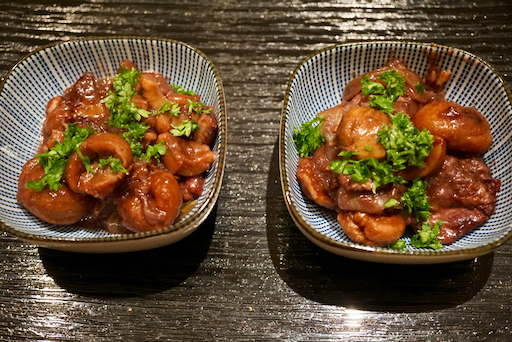For some years we have gotten fresh North American chestnuts from California. It is
a lot of work to peel/clean chestnuts. It is particularly hard to remove the internal brown membrane or “shibukawa” 渋皮 that extends into the meat of the chestnut and is a particular characteristic of North American chestnuts. The chestnuts we got from California last year were a bit disappointing. They were kind of dry and chalky. So this year we got
prepared chestnuts in a jar. According to the label they appear to have been packaged/processed in France but the chestnuts themselves originated in unspecified EU countries. It said “roasted chestnuts” but in fact they were steamed. When we opened the jar, many of the chestnuts were fragmented with a few whole intact chestnuts tucked in at the top. They were not sweetened and tasted fairly good with nice texture**. So I decided use the chestnuts for
this stew dish I saw on line. Since I had leftover daikon and burdock root I need to use up this recipe was a perfect choice. Although the recipe calls for “
renkon” 蓮根 lotus root, I did not have it. I made this one weekend morning and served this as a lunch with
kinpira-gobou 金平牛蒡 and rice.
**Interestingly, my wife discovered while eating the dish I made that several of the chestnuts indeed had the internal brown membrane. These membranes were left in the nut and the nut was just processed as if they weren’t there. It was a rather unpleasant surprise to bite down unexpectedly on the hard shell-like substance. After that she recommended checking the chestnuts as they come out of the jar and if necessary dismantling them to remove any membrane left. We saw this as a sloppy element of the processing.
Not all the items I put in the dish are seen in the picture. I also put in konjack or konnyaku こんにゃく.The seasoning is typical Japanese but the kobou flavor comes through strongly. While simmering, the chestnuts broke into large chunks but tasted good.
According to the recipe the chicken was to be cooked in water with sake and scallion before adding to the rest of the ingredients. I would have just put the cut up chicken into the stew. I suppose this extra process would reduce “chicken-ness”.
Ingredients (at least 4 fairly good size servings).
For pre-cooking of the chickenTwo chicken thigh, bone removed (I left the skin on) .
2 tbs sake
2 scallions
several slices of ginger
12000 ml water
For stew2-3 inch daikon, peeled, cut into 1/2 inch thick rounds and then quarters
2-3 carrots, peeled and cut into bite sized pieces (“rangiri” 乱切り cut at 45 degree angle as you rotate the carrot)
1/2 “gobou” burdock root, skin scraped off using the back of the knife and also cut into bite sized pieces using “rangiri”
2 inch long renkon, skin peeled and cut into 1/4 inch thick half moon (I did not have renkon).
1/2 Konnyaku, torn into small bite sized pieces by hand (irregular shapes increase the surface areas), parboiled and drained
10-15 parboiled green beans
12-15 chestnuts (original recipe calls for roasted and sweetened chestnuts called “Tenshin amaguri” 天津甘栗.
For cooking liquid250ml of the water in which the chicken was cooked
250ml dashi broth
100ml sake
3 tbs mirin
3 tbs soy sauce
1-2 slices of ginger cut into julienne
Directions:
For pre-cooking the chickenAdd the sake, ginger and scallion to the water and let it come to a boil then place the chicken into the water.
Turn down the flame to simmer and let it cook for 5 minutes and then turn off the flame. Let it stand for 15 minutes (the original instructions said cook for15 minutes but I thought that would be overcooking especially since the chicken will be simmered again with the vegetables).
Take out the chicken and cut into bite sizes pieces.
Keep the water which was used for cooking the chicken to cook the vegetables.
For stewAdd the chicken cooking liquid to a pan
Add the chicken, vegetables and konnyaku
Cook them on medium high flame
Once it starts boiling, turn down to simmer, add the chestnuts and cook for 20 minutes.
Add the green beans in the last 5 minutes.
This has a typical Japanese flavor profile. I am not sure pre-cooking the chicken is necessary. The prepared chestnuts had a natural sweetness and the entire dish was really nice if not outstanding. The quality of the jarred chestnuts was not the best we have ever had but it was still a lot easier then trying to process the raw chestnuts and tasted better too.


























